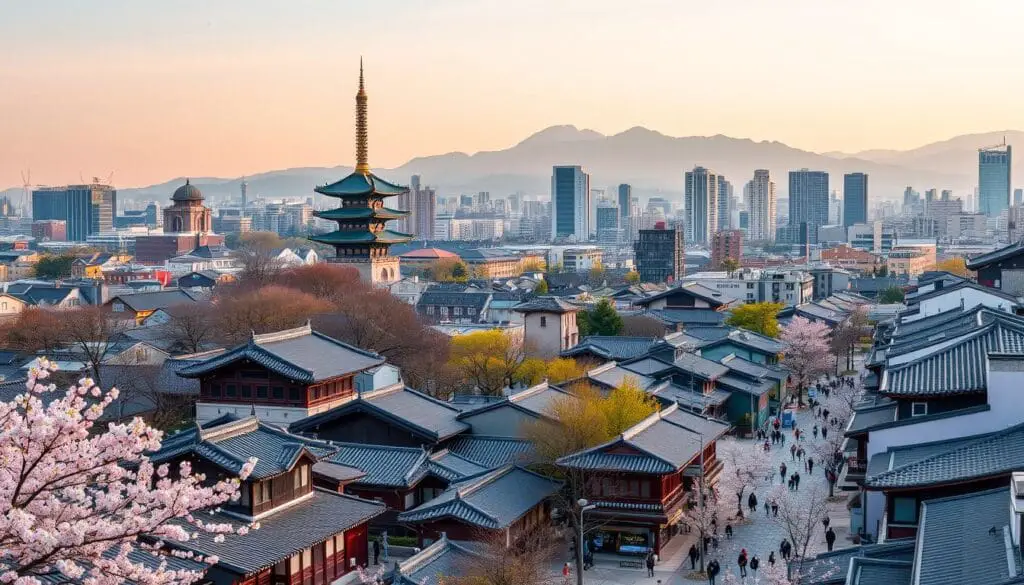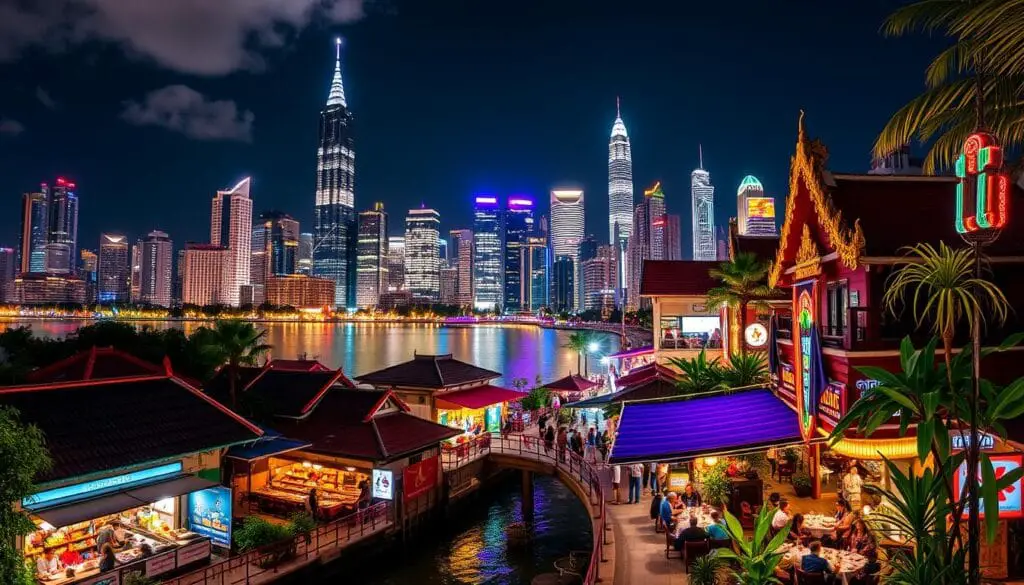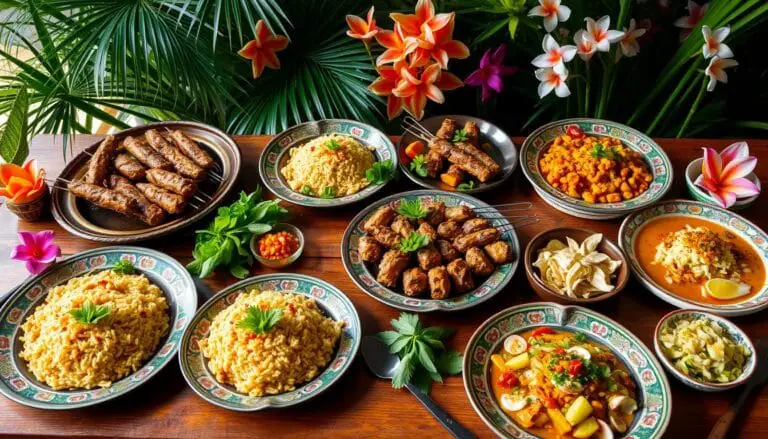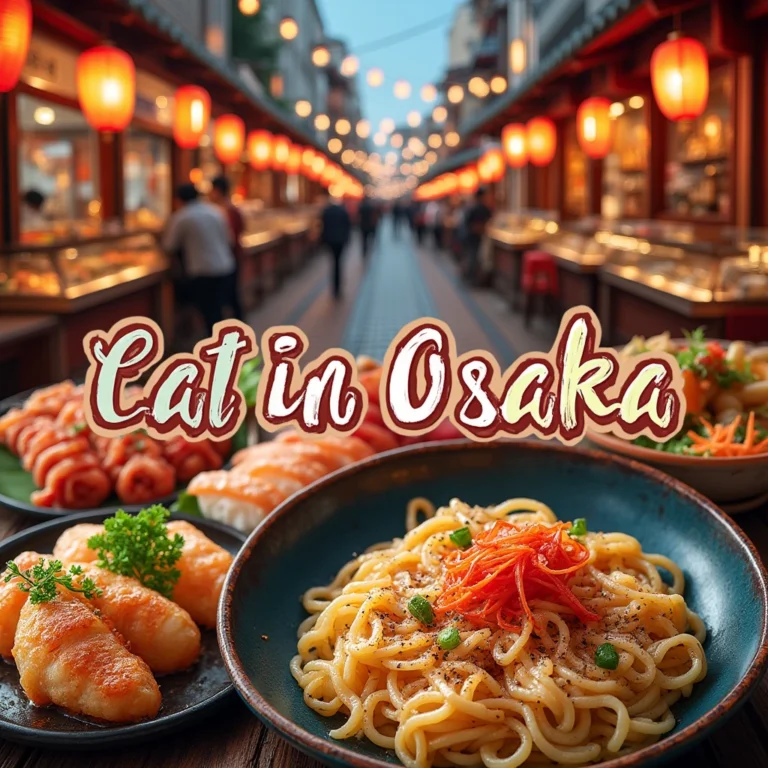Singapore vs South Korea: 7 Compelling Reasons to Visit
As I sip my morning coffee, I feel a strong urge to explore new places. The idea of diving into different cultures and experiencing unique charms excites me. Singapore and South Korea have always fascinated me, and today, I want to share why you should visit them too.
Table of Contents
A Tale of Two Asian Tigers: Understanding the Basics
Singapore and South Korea are known as the “Asian Tigers.” They have amazed the world with their fast economic growth. To really get to know these places, we need to look at their locations, climates, people, and cultures.
Geographic Location and Climate
Singapore is a city-state in Southeast Asia. It has a tropical climate with warm weather and high humidity all year. South Korea, in East Asia, has four seasons. It gets cold winters and hot, humid summers.
Population and Demographics
Singapore has about 5.7 million people. They come from many ethnic groups like Chinese, Malay, Indian, and Eurasian. South Korea has around 51.8 million people. Most are ethnic Koreans.
Language and Cultural Overview
In Singapore, English is the official language. This shows its colonial past and role as an international center. But, Mandarin Chinese, Malay, and Tamil are also common. In South Korea, Korean is the official language. It has its own script and culture, influenced by Confucianism and Buddhism.
These differences make Singapore and South Korea unique. They are both exciting places to visit, whether you’re traveling to Singapore or South Korea.
Transportation and Accessibility: Getting Around Both Countries
Both Singapore and South Korea have great ways to get around. Singapore has a big MRT network and buses. South Korea has fast KTX trains and subway systems in cities like Seoul.
In Singapore, the MRT is key for getting around. It has six lines and over 100 stations. It’s fast to places like Marina Bay Sands and Gardens by the Bay. Buses also help, covering many areas of the city.
South Korea’s KTX trains are fast, reaching up to 350 km/h. They connect cities like Seoul and Busan. Seoul’s subway is also great for getting around the city.
| Transportation Options | Singapore | South Korea |
|---|---|---|
| Metro/Subway System | Extensive MRT network with 6 color-coded lines and over 100 stations | Comprehensive subway systems in major cities like Seoul, Busan, and Daegu |
| High-Speed Trains | N/A | KTX high-speed rail network connecting major cities at speeds up to 350 km/h |
| Buses | Robust bus network complementing the MRT system | City buses with a basic fare of 1,300 KRW (approximately $1.10 USD) |
| Taxis and Ride-Sharing | Widely available taxis and popular ride-sharing services like Grab | Taxis and ride-sharing services like Kakao Mobility available |
| Car Rentals | Convenient option for exploring the city and nearby islands | Viable option for traveling between cities and visiting rural areas |
Transportation cards make traveling easy in both countries. In South Korea, it’s the T-money Card. In Singapore, it’s the EZ-Link Card. They work on buses, trains, and some taxis.
Whether you like public transport or renting a car, both places have what you need. They make seeing their sights and attractions easy.
Singapore vs South Korea: Cultural Heritage and Modern Life
Dive into the mix of old traditions and new city life in Singapore and South Korea. These Asian cities show how old customs and new tech can live together.
Traditional Customs and Festivals
In Singapore, the Chinese New Year is a big deal. You’ll see parades, lion dances, and big feasts. In South Korea, the Chuseok festival is all about family and food, with games and special dishes.
Contemporary Urban Lifestyle
Check out Singapore has Seoul, where old palaces meet new skyscrapers. It’s a mix of old and new that’s really interesting.
Architecture and City Planning
In Singapore, you’ll see old shop houses and big government buildings. In South Korea, places like the Dongdaemun Design Plaza show off modern style. These buildings tell stories of each country’s culture and how cities have changed.
Singapore and South Korea offer a harmonious balance between preserving their rich cultural heritage and embracing the dynamic forces of modernization and progress.
Culinary Adventures: From Street Food to Fine Dining
Start an exciting food journey in Singapore and South Korea. You’ll find amazing flavors in both places. From Singapore’s lively hawker centers to South Korea’s street food markets, your taste buds will thank you.
Singapore’s food scene is a mix of many cultures. Visit the hawker centers to try chili crab, Hainanese chicken rice, and laksa. These places show how Malay, Chinese, Indian, and Peranakan cuisines blend together in Singapore.
South Korea’s street food is also a must-try. In Seoul’s markets, enjoy tteokbokki, hotteok, and bibimbap. It’s a mix of old and new flavors that will excite you.
Both places also offer top-notch fine dining. You can find Michelin-starred restaurants and hidden spots. These places serve dishes that take local flavors to the next level.
Looking for spicy South Korean food or Singapore’s diverse flavors? Your food adventures in these places will surely impress you.
Must-Visit Attractions in Singapore
Singapore is a vibrant and diverse place. It has modern wonders and rich cultural heritage. The city-state is famous for its iconic attractions that leave visitors amazed.
From the futuristic Marina Bay Sands to the magical Gardens by the Bay, Singapore’s skyline shows its architectural genius.
Marina Bay Sands and Gardens by the Bay
The Marina Bay Sands complex is a top attraction in Singapore. It has the world’s largest rooftop infinity pool, offering stunning views. Next to it, the Gardens by the Bay is a botanical marvel with towering “Supertree” structures and enchanting conservatories.
Sentosa Island Highlights
Sentosa Island is close to the city center and loved by many. It has pristine beaches, thrilling theme park rides, and cultural sites. Don’t miss the Singapore Flyer, a giant Ferris wheel with panoramic views.
Cultural Districts and Heritage Sites
Singapore’s cultural diversity shines in its neighborhoods. Visit Chinatown and Little India to experience unique sights, sounds, and smells. The Peranakan Museum showcases rich heritage, and Kampong Glam area offers Malay-Islamic influences.
Singapore’s attractions are unforgettable for those who love top attractions in singapore and tourism destinations.
Essential South Korean Destinations

Discover the beauty of South Korea’s top spots. From bustling Seoul to peaceful nature, this country has it all. You’ll find experiences that will amaze you.
Begin in Seoul, South Korea’s lively heart. Visit the Gyeongbokgung Palace, a 14th-century gem. Then, walk the 11km-long Cheonggyecheon Stream, a peaceful city path. Don’t miss the views from the N Seoul Tower.
Next, head to Gyeongju, called the “museum without walls.” This city was the Silla Kingdom’s capital from 57 BC to 935 AD. See the Seokguram Grotto and Bulguksa Temple, both UNESCO sites.
- See the beauty of Seoraksan National Park. It has tall mountains, green forests, and the Sinheungsa Temple with a huge bronze Buddha.
- Visit Busan, South Korea’s second-biggest city. Enjoy the lively Jagalchi Fish Market and the UN Memorial Cemetery, honoring Korean War soldiers.
- Check out the Demilitarized Zone (DMZ). It’s a guarded area between North and South Korea, showing the region’s complex history.
South Korea has it all, from Seoul’s modern sights to Gyeongju’s ancient wonders and Seoraksan’s nature. It’s a mix of top attractions and tourism destinations that will impress every visitor.
Shopping Paradise: Markets and Malls
Singapore and South Korea are shopping wonders. They mix old markets with new malls for all shoppers. Dive into the lively shopping scenes of these Asian spots.
Traditional Markets vs Modern Shopping Centers
In Singapore, old and new meet. Bugis Street Market is full of local goods and street food. Nearby, Orchard Road has fancy stores and malls like Marina Bay Sands.
South Korea mixes tradition with modern shopping. Dongdaemun Market in Seoul has lots of fashion and local items. Myeongdong and Garosugil show off K-fashion and beauty in trendy malls.
Best Shopping Districts in Both Countries
- In Singapore, don’t miss Orchard Road, Haji Lane, and Chinatown markets.
- In South Korea, Myeongdong and Dongdaemun in Seoul are top for fashion and electronics.
Looking for luxury, local finds, or the latest trends? Singapore and South Korea have it all. Explore their lively and varied shopping scenes.
Entertainment and Nightlife Scene

Singapore and South Korea have lively entertainment and nightlife scenes. In Singapore, Marina Bay Sands casino and Clarke Quay nightlife district are top spots. They offer fun and excitement for everyone.
In South Korea, Hongdae and Itaewon in Seoul are buzzing with life. They have karaoke rooms, themed cafes, and energetic clubs. Both countries also have vibrant music and arts scenes with many concerts and festivals.
Nightlife in South Korea
Hongdae in Seoul is a major nightlife spot in South Korea. But, some places might not allow foreigners. Dinner and drinks cost about $30 per person, and karaoke rooms are 4 USD per hour.
Hongdae offers more than just bars and clubs. You can try photo booths, arcades, and other fun activities. The area’s nightlife shows South Korea’s changing trends, like less alcohol and fewer karaoke bars.
Entertainment in Singapore
Singapore’s nightlife is just as lively, with Marina Bay Sands and Clarke Quay being favorites. These spots have clubs, bars, and restaurants for all tastes.
Singapore also has a strong music and arts scene. There are many concerts, festivals, and cultural performances all year. It’s a mix of old and new, offering something for everyone.
The nightlife in Singapore and South Korea offers a unique blend of traditional and contemporary entertainment, catering to a wide range of interests and preferences.
Cost Comparison and Travel Budget Planning
Planning a trip means looking at your travel budget first. It’s important to compare costs in Singapore and South Korea. This helps you make smart choices and enjoy your trip more. Let’s look at where to stay and what daily expenses are like in these places.
Accommodation Options
In Singapore, staying in a dorm bed costs about $20-$35 per night. Capsule hotels are $35-$60, and mid-range hotels are $80-$250. Luxury hotels can be over $250 per night.
South Korea has more affordable places to stay. You can find hostels and guesthouses for $27 per night. Mid-range hotels are $67, and luxury hotels are about $153 per night.
Daily Expenses and Transportation Costs
- Food in South Korea is cheaper, with budget meals at $15 a day and mid-range meals at $40.
- In Singapore, eating out costs more, with budget meals at $15-$20 and mid-range meals from $40 to $100 a day.
- Transport in South Korea, like buses and subways, is cheap, with a ride costing $1-$2.
- In Singapore, public transport is more expensive, with a ride costing $1-$3.
South Korea is more budget-friendly for accommodation and daily costs. But, both places offer choices for different budgets and preferences.
| Cost Comparison | Singapore | South Korea |
|---|---|---|
| Accommodation (per night) |
|
|
| Food (per day) |
|
|
| Local Transportation (per ride) | $1-$3 | $1-$2 |
By looking at where to stay and daily costs in Singapore and South Korea, you can plan your travel budget better. This way, you can enjoy your trip to the fullest.
Best Times to Visit Each Country
Planning your trip to Singapore or South Korea? Timing is everything. Both countries have their own charm by season. Knowing when to go can make your trip better. Let’s look at the best times to visit these amazing places.
Singapore is warm all year, but the dry months from February to April are the best. The weather is perfect for exploring outside. But, the southwest monsoon season from June to September brings more rain, making it less ideal.
South Korea has four seasons, each beautiful in its own way. Spring (March to May) and autumn (September to November) are the best times. You can see the stunning cherry blossoms or the colorful fall foliage. It’s a perfect time for your South Korean journey.
Both Singapore and South Korea have lots to offer all year. You can enjoy the city life, culture, or food anytime. The best time to visit Singapore and South Korea depends on what you want to see and do.
Conclusion
Singapore and South Korea are two amazing places in Asia. They offer many unique experiences for travelers. Each country has its own special things to see and do.
Singapore is known for its modern buildings, diverse culture, and top attractions. It’s a city that mixes old and new perfectly. South Korea, on the other hand, is famous for its tech, culture, and pop scene. It has everything from busy Seoul to peaceful Jeju Island.
Looking for a city adventure, cultural dive, or food trip? Both singapore vs south korea have what you need. They are among the top best travel destination in asia. By visiting these places, you can make memories that will last forever. So, why not explore the best of both worlds in Singapore and South Korea?
Check Out These Posts :
- Food of Taiwan: 10 Unmissable Dishes Every Adventurous Traveler Must Try
- The Best 10 Day Itinerary for Japan: Unforgettable Travel Guide to Explore Tokyo, Kyoto, Osaka & Beyond
- Travel Solo in Thailand: Your Ultimate Guide to Safe and Memorable Adventures
FAQ
What are the key differences between Singapore and South Korea in terms of geographic location and climate?
Singapore is a city-state in Southeast Asia with a tropical climate. South Korea is in East Asia and has four distinct seasons.
How do the populations and demographics of Singapore and South Korea compare?
Singapore has a smaller population but is more diverse. It has Chinese, Malay, Indian, and other ethnic groups. South Korea has a larger population that is mostly ethnically Korean.
What are the main transportation options for getting around in Singapore and South Korea?
Singapore has a good MRT network and bus system. South Korea offers high-speed KTX trains and subway networks in big cities. Both countries also have taxis, ride-sharing, and car rentals for tourists.
How do the traditional customs and modern lifestyles differ between Singapore and South Korea?
Both countries celebrate unique festivals like Chinese New Year in Singapore and Chuseok in South Korea. They have a mix of traditional and modern landscapes. Singapore has a futuristic cityscape, while Seoul has ancient palaces and skyscrapers.
What are the top attractions and must-visit destinations in Singapore and South Korea?
Singapore’s top spots include Marina Bay Sands, Gardens by the Bay, Sentosa Island, and cultural areas like Chinatown and Little India. South Korea’s must-sees are Seoul’s palaces and temples, historic Gyeongju, Jeju Island, and lively Busan.
How do the shopping experiences compare between Singapore and South Korea?
Both countries have traditional markets and modern malls. Singapore is famous for luxury shopping on Orchard Road and unique finds in Haji Lane. South Korea’s trendy spots include Myeongdong and Dongdaemun in Seoul.
What are the best times of the year to visit Singapore and South Korea?
Singapore’s tropical climate makes it visitable all year, with dry weather from February to April. South Korea’s best times are spring (March to May) and autumn (September to November) for mild weather and beautiful scenery.













